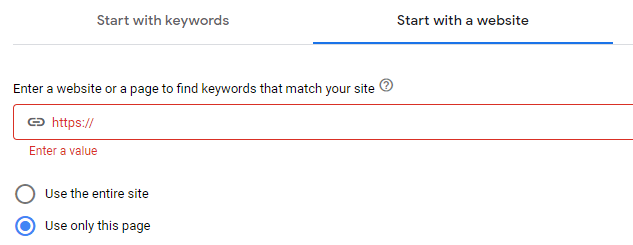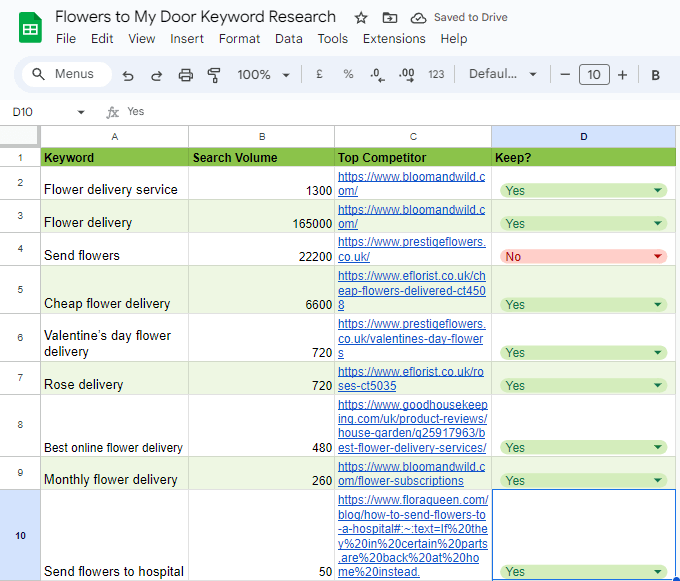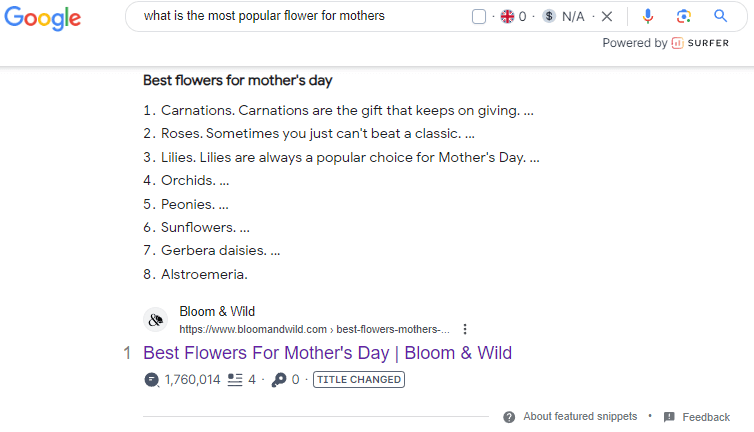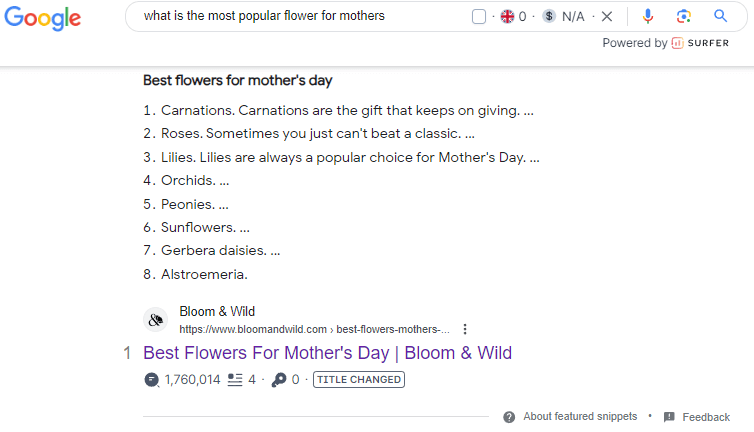Keyword Research for Beginners: Kickstart Your SEO Process for Free
Keyword research is the essential first step to any SEO campaign, and a successful keyword strategy can increase your business’s customer base, revenue, and website traffic.
Google uses keywords to understand what the content of your website offers users. No matter what type of business you run, keywords provide a free and simple way to market your brand to organic users – users that may never have heard of your company before. In the modern world of search engines, keywords are a powerful and free advertising tool that, when used correctly, can increase your brand awareness to the biggest user base on earth – Google searchers.
In this blog, you will discover the best ways to conduct your keyword research for free with a number of powerful tools, extensions, and best practices.
What is Keyword Research?
The process of keyword research involves exploring relatable keywords for your brand that organic users are searching; as well as which keywords are working for competitor brands, and keywords that may provide a suitable niche for your business to explore.
Finding a list of both low and high volume keywords will inform the terms you should use in your website’s content.
Why is Keyword Research Important?
A comprehensive keyword research process can maximise the potential for your business to reach a new customer base, and help you discover new services or products that your brand could offer users. Keyword research isn’t simply about finding terms to use in your website’s content, it is also an extensive market research tool that provides businesses with new ideas and insight into their respective industry.
For this blog, we are going to begin the keyword research process for an exciting new company, Flowers to My Door, to show you exactly how each step of the keyword research process not only benefits your SEO strategy, but can also benefit your overall business model.
What are the 3 Steps to Keyword Searching?
Keyword research can be broken down into 3 simple steps:
1. Keyword Research
The initial phase in your keyword strategy. Comprehensive keyword research will provide you with everything needed to create high-quality, SEO optimised content, by utilising tools that show keyword search volume and keyword variations.
2. Keyword Mapping
Keyword mapping involves defining which areas of your site will use specific keywords. This is an important step in the SEO keyword research and implementation process, as it will help you avoid issues such as keyword cannibalisation – where the same keyword is used across multiple pages on a website.
3. Implementing Keywords
Once your keyword research and keyword mapping is finished you can begin implementing keywords into your content, which will help your website to rank higher for specific keywords.
If your content is well-written, informative, and adheres to the intent of the keyword, you will have a better chance of ranking in the top results for a given keyword.
We have provided a detailed explanation of these steps below using our fictional company, Flowers to My Door, as an example.
How to Find Keyword Ideas
Define Your Starting Keywords
The first step in finding keywords for your website is to define a list of starting keywords. Think about which terms and ideas are relevant to your business and the services you offer, and how you would use Google to search for a business that offers the same services as yours.
In the case of our example business, Flowers to My Door, the company offers a doorstep flower delivery service where customers can order flowers for themselves or as a gift for others. In this instance, their starting keywords might be:
- Flower delivery service
- At home flower delivery service
- Doorstep flower delivery
- Order flowers for a gift
- Birthday flower delivery service
This is what is known as your ‘seed’ keywords – terms you can begin with to gather ideas, search volume, and keyword variations.
Use Free Tools to Find Related Keywords
Once you have an idea of your seed keywords, you can use free research tools to gather keyword ideas and search volumes. In this example we will be using Google’s Keyword Planner, which is free to use.
Beginning with Google Keyword Planner we input the first seed term, “flower delivery service”, to discover new keywords.

The results page shows over 500 keyword ideas that Flowers to My Door could use, with a number of high and low search volumes. This includes:
| Keyword | Search Volume |
|---|---|
| Flower delivery service | 1,300 |
| Flower delivery | 165,000 |
| Send flowers | 22,200 |
| Cheap flower delivery | 6,600 |
| Valentine’s day flower delivery | 720 |
| Rose delivery | 720 |
| Best online flower delivery | 480 |
| Monthly flower delivery | 260 |
| Send flowers to hospital | 50 |
In this instance, Keyword Planner has produced a variety of terms that Flowers to My Door could implement in their keyword strategy, and furthermore, could even influence the services the company offers – this is referred to as a niche.
In terms of our company name, Flowers to My Door, this brand name was selected because the keyword ‘flowers to my door’ appeared in our keyword research with a monthly search volume of 40. This is just one example of how keyword research can inform your overall business strategy.
Be Aware of Search Volume
Search volume is an extremely important metric to be aware of when conducting keyword research. It may be tempting to look at the keywords that have the highest search volume, but bear in mind that these keywords will have the biggest competition, and will likely be in use by the biggest companies in a given industry.
If you are a new company with little-to-no foothold in your market, you should aim to include both low and high search volume keywords in your campaign, with a view to capitalise on keywords with a smaller search volume for a better chance to appear in the search results.
Keywords with a high search volume generally fall into the category of ‘short-tail keywords’ – terms that are either generic or non-specific, whereas low search volume keywords are usually ‘long-tail keywords’ – terms that are targeted or specific.
In the above example, the keyword ‘flower delivery’ is a short-tail keyword, as there could be many nuances to this term that are not fully explained in the individual keyword, and the term ‘send flowers to hospital’ is considered a long-tail keyword, as the term is specific; relevant to a niche, and leaves little room for interpretation or a mixture of intents.
With regards to our company, Flowers to My Door, implementing the keyword ‘send flowers to hospital’ may present a viable opportunity to not only rank highly for this keyword, but it could also inform the types of service the company offers in the future. This is known as a niche – more on this later.
Check Competitor Keywords
Who are your main competitors? When we talk about competition for a new-starter company like Flowers to My Door, we aren’t simply referring to the biggest competition in the market such as Bloom & Wild or Prestige Flowers, we are also referring to smaller companies that can only be found through niche terms such as the ‘send flowers to hospital’ keyword.
Although it is important to consider the biggest players in your market and the strategies they implement, the reality is that you may struggle to outrank them for generic or ‘short-tail’ keywords. Make sure to gather a comprehensive list of competitors both big and small, and research both the keywords they use and the way in which they implement these keywords into their content.
Competitor keyword research can be conducted in a number of ways. Let’s start by using the keyword ‘rose delivery’, which has a search volume of 720.
Your first step is to enter this keyword into Google and make a note of the top results for this term. Copy the URL of the first ranking page and navigate to Google Keyword Planner, then on the top bar select ‘Start with a website’, paste the URL into the bar, then select ‘Use only this page’

This will show you all relevant keywords that appear on the competitor’s page, which will provide you with further terms that can be added to your keyword research. In this instance, the competitor article also contains the following keywords:
| Keyword | Search Volume |
|---|---|
| Red roses delivery | 720 |
| Send roses | 390 |
| Bouquet of roses | 2,400 |
Using this method you can easily find keywords, keyword variations, and the way your competitors are using the term in their content. This information should inform how you create your content.
Discover a Niche Through Your Research
As discussed above, you may discover a market niche through your keyword research that can be useful for creating targeted content, or even inform your future business model.
In the keyword research for Flowers to My Door we discovered the keyword ‘send flowers to hospital’. Imagine you are the owner of Flowers to My Door, with your initial plans being to simply offer a generic flower delivery service. You may be confident in your business model, but the market is already saturated with companies that offer a flower delivery service. Through discovering this keyword you have also discovered a niche service that your business could offer, allowing you to stand out from the crowd.
It can be easy to overlook low search volume terms such as this, but it is important to remember that, although this term only has a monthly search volume of 50, that search volume represents 50 new customers who will discover your business if the keyword is correctly utilised.
In terms of the ‘send flowers to hospital’ keyword, you may decide to create a specific service page that targets this keyword, thereby expanding your company’s offerings and capitalising on a niche that other competitors may not have considered. This is particularly relevant when trying to compete against bigger companies, who are less likely to utilise long-tail keywords such as this.
Keyword Analysis: Understanding User Intent
User intent is an incredibly important factor for keyword ranking, and understanding a user’s intentions when searching specific terms is essential to gaining rankings. When deciding on the content you will create around a given keyword, it is important to research the keyword intent to ensure the information you are offering is relevant to what users are looking for.
Here is an example taken from Flowers to My Door’s keyword research:
The keyword ‘online florist’ came up in our research with a search volume of 1900, and the keyword suggests the user is looking for an online flower delivery service – which is correct. However, taking a look much further into the Google results pages shows there are a number of smaller businesses that have used this keyword in relation to a different type of service.
The first company we discovered offered an online herbal flower remedy service, where the business model revolved around online consultations with clients to determine which types of flowers could be used in a bespoke herbal remedy for the customer. In another example, we found a company offering consultation services that uses video calls to examine and diagnose problems with customers’ plants or gardens.
In this example, the term ‘online florist’ is technically relevant to both services, but in terms of the keyword intent on Google, neither of these services are what users are looking for when searching the keyword. It is for this reason that both services do not rank well for this keyword – even if the content of the website is well written and optimised, if the intent does not match the keyword is not likely to rank.
Keyword intent doesn’t just refer to the types of service on offer, it can also refer to the format of the ranking page – for instance if the page is a blog or offers a service.
The intent of your keyword could be either informational, transactional, or navigational. For instance, a user searching ‘buy flowers online’ is likely looking for a page where they can buy flowers. In this instance the keyword is transactional, and the page you map this keyword to should be a product page. However, if a user searches the term ‘how to keep flowers fresh’, the user is looking for information about how to care for their flowers, and in this case, it might be beneficial to provide a blog post aimed at answering this question.
Use Google Sheets to List Your Keyword Ideas
Google Sheets is a tool provided by Google for any user with a Gmail account. It works almost identical to Microsoft Excel, but is completely free to use.
During the research process, you should make an initial list containing all relevant keywords, their search volume, related competitor pages, and any other information that may relate to the keyword. Once you have completed the research stage you can go through this list to determine which keywords you will keep, which can then be added to your keyword map.
Here is an example of how a keyword research sheet could look:

Using Google Sheets will help you to organise your listed keywords, and is an important tool to keep track of any terms you will use in an SEO keyword campaign.
What to do After Finding Keywords: Keyword Mapping
Now we have a comprehensive list of keywords taken from Google Keyword Planner and competitor research, we can begin to map specific primary and secondary keywords to each page of our site.
Remember, keyword mapping is an essential step to avoid keyword cannibalisation issues.
Gather Your Website’s URLs
The first step to creating a keyword map is to gather a list of all URLs on a sheet. If your website is not yet online, then you can write down a list of your planned pages, but if your website is already established and online then you can use a tool such as Google Search Console to download a list of your indexed URLs.
Once you have a list of URLs, you can determine which keywords would be best suited to each page. Remember to take into consideration user intent and search volume.
Map Keywords to Each URL
Your next step is to map both primary and secondary keywords to each page. Your primary keyword is your main focus term for the page’s content, and will likely feature in the meta title or H1 (first heading) of your page, with secondary keywords appearing in later headers and throughout the content.
Remember not to use the same keyword across multiple pages in most cases, as this can cause an issue known as ‘keyword cannibalisation’ – which we explain below.

In the above example, we have mapped the term ‘flower delivery service’ to the Flowers to My Door Homepage, as this is exactly what consumers are looking for when searching this keyword. However, you will notice that the secondary keywords for the Gifts service page cover a range of topics including Valentine’s and Mother’s Day. In this instance, Flowers to My Door will offer all of these services on the same page, but you could also create individual pages for each of these services with the specific keywords mapped as the primary keywords for each page.
Save Keywords for Blog Content
Remember that you don’t need to map every keyword in your campaign to a page, as some of these terms should also be used for blog content – particularly any keywords you have tagged as informational.
For instance, the keyword ‘flower delivery mothers day’ is perfectly suited to a service page, as this matches the intent of the keyword based on the top results on Google:

Whereas the keyword ‘what is the most popular flower for mothers’ has informational intent, meaning that users are looking for blogs or lists that answer their question, as seen in these search results:

In this example, we can see that it is beneficial to hold back a number of informational keywords for your blog content. Bloom & Wild effectively use this blog as a means of providing information to the user, which has gained them the ‘featured snippet’, and the blog itself provides a strong link structure back to their individual product pages.
Be Aware of Keyword Cannibalisation
Keyword cannibalisation is an issue that is caused by the same keyword being used across multiple pages. Keywords not only indicate to Google the type of content a webpage offers, but they also tell Google which specific page you want to serve users who are searching the keyword.
If you use the same keyword across multiple pages Google won’t know which page you want users to see, and this may result in your website not appearing in the search results.
What to do With Your Keywords
Now that Flowers to My Door has a comprehensive keyword map we can begin to implement these keywords into our content.
1. Create Meta Titles and Descriptions
Starting with meta titles and descriptions, you can append your keyword map to include a section for metadata that includes both primary and secondary keywords.
For instance, Flowers to My Door’s homepage has the ‘flower delivery service’ keyword mapped as the primary term, with some of the secondary keywords being ‘best online flower delivery’ and ‘online florist’.
The company could therefore use the following as a meta title:
“Flower Delivery Service | Buy Online | Flowers to My Door”
And the following as a meta description:
“Discover the UK’s best online flower delivery company – order before 3pm for same-day delivery. Need help? Our online florists are available 9am to 5pm”
In these examples we have used the primary keyword in the meta title of the page, with 2 of the secondary keywords in the meta description. Creating and uploading optimised metadata is the easiest way to help Google users understand what your page is offering.
Read our blog: Meta Tag SEO: A Best-Practice Guide
2. Explore SERP Features
Search Engine Results Page (SERP) features refers to the types of results users are shown when searching different keywords. You may notice that when you search an informational keyword such as ‘best flowers for mothers day’, the first result shows a list above a website URL:

This is known as a featured snippet, and it is one of many types of SERP features Google provides depending on the intent of a keyword. Other SERP features may include product images, people also ask questions, video results, local features, and more.
By exploring the SERP features that appear for your keywords, you can begin to understand the type of content Google prefers for a given keyword, and so, if you search a keyword and a featured snippet appears with a short paragraph explaining the keyword, you should aim to replicate this style of content within your own page for this term.
3. Create On-Page Content
Your next step is to create the text content that will appear on each page. This content should include your mapped keywords as either headers, or within the paragraph text itself. Remember to keep your sentence structure as natural as possible and avoid ‘keyword stuffing’ – where the overuse of a keyword makes a sentence appear unnatural.
An example of keyword stuffing for Flowers to My Door’s content would be:
“Flowers to My Door is an online flower delivery service offering flower delivery services straight to your door! We have been providing customers with expert flower delivery services for over 10 years, and we offer a range of flower delivery services for every occasion.
Order before 3pm for same-day flower delivery straight to your door!”
Did you spot the keyword? Overusing keywords creates a negative user experience, and Google may penalise your website if you use keyword stuffing tactics.
Creating content that is easy to read, with appropriate mentions of each keyword, is one of the best ways to help secure rankings for your website.
4. Create Blogs
Finally, you should look into creating blogs for your website that provide relevant information for users about your company, the services you offer, and any other information that may entice users to convert into customers.
In the case of Flowers to My Door, we have seen in the above points that a blog describing the ‘Best Flowers for Mother’s Day’ could work well for the site, but each company will be different. Through your keyword research you will likely discover a range of topics that can be covered by your blog posts, and this is an important factor in moving up in keyword ranks.
Try to make your content as informative and valuable as possible, utilising a range of relevant keywords that best suit each topic.
Conclusion: How Keyword Research Helps Your Company
Through the process of keyword research we have not only developed an understanding of how our competitors rank for certain keywords, but we have also discovered new niches to be filled by our website, Flowers to My Door, such as hospital flowers delivery services or monthly flower delivery.
As a new company, Flowers to My Door can use everything we have learnt through keyword research to optimise the content of their website and increase their chances of ranking highly on Google by offering new services, creating informative content, and matching the intent of organic users.
For larger companies with a lot of brand awareness or Domain Authority, you can utilise generic or ‘short-tail’ keywords to help retain key positions in search engines. For smaller companies, such as Flowers to My Door, keyword research is an essential and exciting first phase of your planning and marketing strategy that can open a lot of doors in terms of discovering a new market, and figuring out where your company fits into your industry.
SEO strategies such as keyword optimisation are an essential part of the search engine economy. Any time you have discovered a new company through Google, Yahoo, or Bing, by searching a generic term, this is achieved through keyword optimisation, and your business can use keyword research to gain a foothold in any industry provided you understand where the strengths of your company lie.
Looking to maximise your SEO potential? Get in touch with our expert team today to discover how The SEO Works can help plan your strategy.

Zak is a Senior Account Executive with a passion for writing informative content, which stems from a love of reading and book writing.

